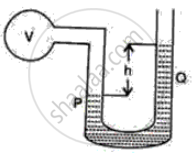Advertisements
Advertisements
प्रश्न
The pressure in the water pipe on the ground floor of a building is 40000 pascals, whereas on the first floor it’s 10000 pascals. Find the height of the first floor. (Acceleration due to gravity g = 10 ms−2)
उत्तर
Pressure on the ground floor of a building = P1 = 40000 Pa
Pressure on the first floor of a building = P2 = 10000 Pa
ρ = 1000 kg/m3 = density of water
Acceleration due to gravity = g = 10 m/s2
Difference in pressure = P1 – P2 = 40000 – 10000 = 30000 Pa
Let h = height of first floor
Pressure of water due to height (h) = hρg
30000 = h × 1000 × 10
h = `30000/10000` = 3 m
APPEARS IN
संबंधित प्रश्न
State Pascal's law of transmission of pressure.
A force of 50 kgf is applied to the smaller piston of a hydraulic machine. Neglecting friction, find the force exerted on the large piston, if the diameters of the pistons are 5 cm and 25 cm respectively.
66640 Pa pressure is exerted by 0.50 m vertical column of a liquid. If g = 9.8 Nkg−1, calculate the density of the liquid.
Select the correct option.
Pressure applied in liquids is transmitted with undiminished force
The atmospheric pressure at a place is 650 mm of Hg. Calculate this pressure in Pascals (Pa).
The following figure shows a manometer containing a liquid of density p. The limb P of the manometer is connected to a vessel V and the limb Q is open to atmosphere. The difference in the levels of liquid in the two limbs of the manometer is h as shown in the diagram. The atmospheric pressure is P0.
(i) What is the pressure on the liquid surface in the limb Q?
(ii) What is the pressure on the liquid surface in the limb P?

State and explain Pascal's law of transmission of pressure.
Analogy
Pascal’s law: ______:: Surface tensin: ______.
